Tinctures are a favored method of extracting medicinal properties from plants. They are one of the oldest herbal preparations, created and used thousands of years ago, and are still widely used today.
What is a Tincture?
A tincture is a concentrated herbal extract that uses alcohol as the solvent.
To understand what a tincture is, we need to also understand what isn’t a tincture. So, a tincture is an herbal extract that uses alcohol as the menstruum (solvent): if the menstruum isn’t alcohol, then the herbal preparation is not a tincture but an extract. An extract uses water, vinegar, or other forms of solvents. An extract that uses glycerin instead of alcohol is called a glycerite. An extract that uses vinegar is called an acetum. Herbs prepared with rubbing alcohol are called liniments and are for external use only — rubbing alcohol can be fatal if taken internally. However, a tincture can be used safely both internally and externally (depending on the herb used).
* Note: essential oils, or other essences, are not tinctures.
Why should we use a Tincture?
A tincture may seem intimidating to make or even to use, but it is really quite simple. As long as we are familiar with our herb material and understand its uses and dosage, a tincture is safe for everyone in the family to use. It is also cost-effective, sustainable, and promotes self-sufficiency.
A tincture is a convenient way to ingest herbal medicine. It is a small, concentrated form of herbal medicine that we can carry around with us. Because tinctures are concentrated, they are strong medicine so dosage is often low. Another benefit is that a tincture doesn’t need to be digested to start working: the alcohol content absorbs quickly into the body, sending the herbal medicine into the bloodstream through the skin, throat, or stomach lining. Tinctures are also good for dosing children, since they are effective and work quickly — a few drops of tincture is easier for an unhappy and sick child to take than a 4 oz cup of infusion (tea).
Some tough plant materials need a powerful solvent to extract their medicinal properties, and alcohol is an effective and safe solvent. Because alcohol is a powerful solvent, more of an herb’s medicinal qualities and components will be extracted than if we simply use water. That being said, some herbs are best extracted using other solvents, so it is important to always do your research.
Alcohol is an effective preservative, which means that our tinctures have a long shelf-life. Tinctures are also friendly to our bodies (simple and natural ingredients) and to the environment, since the by-product (herb matter) can be composted.
The alcohol content of a tincture is safe for children, pregnant and nursing mothers: the alcohol content of a full ounce of tincture (~30 drops usual complete dose) is equal to consuming 1-2 ripe bananas. However, while the solvent itself is safe, you must do your research because some herbs are not safe for children, fetuses or babies. I highly recommend talking with a naturopath, doctor, or other certified herbal professional before treating children, chronic disease/illness, or if you are taking other forms of medications since some herbs can interact with pharmaceuticals.
How to Make a Tincture:
I specified that this is the Folk Method or ‘simpler’s method’ because we will use an imprecise method that will create a fine but inconsistent tincture. This method works by simply filling our jar with herb and then adding in alcohol (80-100 proof) at about a 50% ratio. This will create a good tincture that works well, but because we are not controlling the variables with a weight-to-volume ratio, we will have inconsistencies across the batch. In short, this means that while using the Folk Method, we can’t accurately replicate our tincture throughout a batch — the tincture itself will be fine, but one jar may be stronger or weaker than another. Commercially-sold tinctures are made in a controlled way, to ensure that each batch comes out balanced with consistent quality and strength. This is important when using tinctures in other formulas!
Herbalist Susun Weed states that the best tinctures are made with fresh herbs. Dried herbs can be used as well, though she compares them as almost different medicines. However, other herbalists, such as Henriette Kress, say that they are virtually indistinguishable in strength.
Powdered herbs are never suitable for tincturing.
There are varying opinions on needing to shake the tincture. What I have learned is that fresh herb tinctures with high percentage of alcohol do not need to be shaken because the alcohol will automatically dehydrate the liquid. However, for dried herb, shake once every day or every few days.
A note on alcohol: 100 proof vodka is the optimal spirit to use for tinctures, because it is clear, fairly inexpensive, and exactly 1/2 water and 1/2 alcohol. When moving out of the ‘folk’ method and into ratios, many tincture recipes will provide instructions for a 50% tincture, which is half water and half alcohol. So, using 100 proof vodka will simplify your tincture making process because it is already half water and half alcohol.
Fresh herbs still have a lot of water in them, which will reduce the amount of alcohol in the tincture and increase risk of spoilage. The lowest concentration of alcohol that you use should be 80 proof. 100 proof is ideal.
There is an argument that pure grain alcohol is only acceptable for fresh herb tinctures. Dried plants have no water in them (they’re dehydrated) and since pure grain alcohol has a low water content, the water-soluble parts in dried herbs will not dissolve/ be extracted by a pure alcohol solvent. There are differing opinions on this argument so you have to come to your own conclusion.
Another note, just for information, is that pharmacists and homeopaths make their tinctures in pure grain alcohol (190 proof). Pure grain alcohol is ideal for extracting gums, resins, and other aromatic/essential oils that are bound tightly in the plant. Many herbalists like to use Everclear (190 proof, 95% pure ethanol, ~5% water) as a solvent because it has no taste and is a very powerful extraction method.
Supplies you will need: clean glass jars with tight fitting lids; cheesecloth or jelly strainer bag; 100 proof vodka; herbs fresh or dried, labels
Folk Method Tincture Directions: Fresh Herb
* Please note that the Folk Method of tincturing is only for herbs that are safe at any dose, since with this method is no way to control the strength or concentration of a batch *
First, you need to ‘garble’ the plants. Garbling refers to separating out the parts of the plant that will be used from the ‘other’ parts — for example, picking out the wilted leaves, woody stems, stray grass, bugs, or other plants that came along when you collected your plant. This helps with the potency of the tincture, since you will remove the parts of the plant that have no medicinal qualities.
Next, finely cut up or grind the fresh herbs to release juice and create more surface area. Tip: try not to cut up the herb on a cutting board, since the color and potency of the plants can be transferred to the cutting board instead of into your tincture. Instead, try to cut with sharp herb scissors directly into your jar if possible.
Now, fill your glass jar up to the brim with your chopped herbs. Use a jar that can be filled to the brim; any extra space can cause some plant material to be exposed to air (oxidize) and spoil.
Pour the alcohol over the herbs, making sure to cover completely — do not leave any space!
Try to get as much air out of the bottle or jar as possible. Air bubbles can cause the herb to mold. Use a butter knife, chopstick, or other stirring utensil to stir and remove the air bubbles. This might also open up more space, so top off with more alcohol.
Now, screw the lid on tightly and give it a good shake.
Label with the date, plant name, alcohol percentage, intended use. It is also a good idea to include where you harvested from. If you are inclined, you can also add what time of day you harvested your plant material and the moon phase.
Store in a cool, dry place, away from direct sunshine.
Fresh herb extracted in high percentage alcohol shouldn’t need to be shaken, but if you would like you can give it a good, vigorous shake every day for a few weeks. If you are want to be extra careful and shake your tincture every day, but you are afraid that you will forget about it, place it in an area that you go every day. Be sure to top off with more alcohol if you see exposed plant matter.
Let your tincture sit for a minimum of 2-6 weeks. Tinctures can keep almost indefinitely (~10 years) as long as the alcohol preserves it. You do not have to decant right at 2-6 weeks.
To decant, take out a cheesecloth or jelly strainer bag and a new, clean jar. Squeeze your tincture through the cheesecloth/jelly strainer bag. You will have leftover herb. This herb needs to be strained again, since the plant will have soaked up alcohol. You can strain it between 2 plates, 2 containers, 2 jars, through a potato ricer. Just be sure to extract the last of your tincture!
Label your new jar with date, plant name, alcohol percentage, intended use. If you know the dosage, add it to the label. Store in a cool, dry place away from direct sunlight.
Folk Method Tincture Directions: Dried Herb
First, make sure your dried herb is finely cut. Do not use powdered herbs.
For dried herb, we will fill the jar to a different level than with fresh herb, because the dried herb will become reconstituted.
Fill your jar 1/2 to 3/4 with herb OR 1/4 to 1/3 with roots (roots will expand by 1/2 their size when reconstituted).
Pour the alcohol over the herbs and cover completely. You will need to monitor during the extraction and top off with alcohol as plant matter becomes exposed to air.
Try to get as many air bubbles out as possible.
Now, screw the lid on tightly and give it a good shake.
Label with the date, plant name, alcohol percentage, intended use. It is also a good idea to include where you harvested from. If you are inclined, you can also add what time of day you harvested your plant material and the moon phase.
Store in a cool, dry place, away from direct sunshine.
Dried herb tinctures will need to be given a good, vigorous shake every few days. Be sure to top off with more alcohol if you see exposed plant matter.
Let your tincture sit for a minimum of 2-6 weeks. Tinctures can keep almost indefinitely (~10 years) as long as the alcohol preserves it. You do not have to decant right at 2-6 weeks.
To decant, take out a cheesecloth or jelly strainer bag and a new, clean jar. Squeeze your tincture through the cheesecloth/jelly strainer bag. You will have leftover herb. This herb needs to be strained again, since the plant will have soaked up alcohol. You can strain it between 2 plates, 2 containers, 2 jars, through a potato ricer. Just be sure to extract the last of your tincture!
Label your new jar with date, plant name, alcohol percentage, intended use. If you know the dosage, add it to the label. Store in a cool, dry place away from direct sunlight.
Happy tincturing!
Some books and other resources I recommend:
- Rosemary Gladstar’s Medicinal Herbs: A Beginner’s Guide: 33 Healing Herbs to Know, Grow, and Use
- Stephen Orr’s the New American Herbal
- How to Make an Herbal Salve
- Top Native Plants to Learn for Herbal Medicine (part 1)
- Top Native Plants to Learn for Herbal Medicine (part 2)
- Wolf College’s Tenets of Herbal Medicine
- Rosemary Gladstar’s Herbs for Vibrant Health
Learn how to confidently identify plants using their unique family patterns in this in-depth video by author of Botany in a Day, Thomas Elpel.
*** For educational purposes only. This information has not been evaluated by the Food and Drug Administration. This information is not intended to diagnose, treat, cure or prevent any disease. We recommend that you consult with a qualified health care practitioner before using herbal products, particularly if you are pregnant, nursing or on any medications. ***
*** Please read our Honorable Harvesting Guidelines before harvesting any plant material. The final guideline is of utmost importance: “Never put anything in your mouth unless you are 100% sure it is safe to ingest.” ***
Disclaimer:
This blog provides general information and discussion about wilderness living skills and related subjects. The words and other content provided in this blog, and in any linked materials, are not intended and should not be construed as medical advice. If the reader or any other person has a medical concern, he or she should consult with an appropriately-licensed physician or other health care worker.
Never disregard professional medical advice or delay in seeking it because of something you have read on this blog or in any linked materials. If you think you may have a medical emergency, call your doctor or emergency services immediately.
The views expressed on this blog and website have no relation to those of any academic, hospital, practice or other institution with which the authors are affiliated.

Hannah began her apprenticeship at Wolf Camp in 2013 and graduated as a lead herbal instructor in 2014. Shegraduated from the University of Oregon in 2014 with a Bachelor’s Degree in Foreign Languages. She has her own blog, where she writes about her love for crafts, animals, plants, cooking, and the outdoors: rainmountaincrafts.com





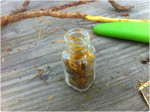




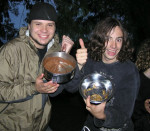

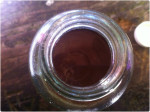
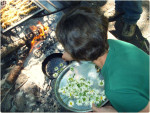
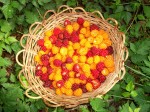
How long is too long to let your tincture soak for? I recently moved and realized I had one soaking since June of 2019, so almost 1 whole year! It smells okay, but is cloudy. Is this safe to use? I would be using topically, not internally. Thanks !
Normally, tinctures are made in a month or less, and varies widely depending on herb. At the one year point, you basically have an potent alcoholic drink that will give a strong headache at least, and probably cause some damage with enough dosage. The cloudiness is a good sign that “when in doubt, throw it out.” – Chris